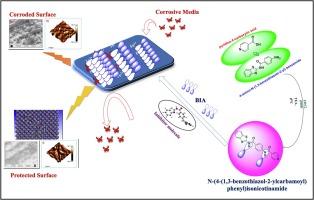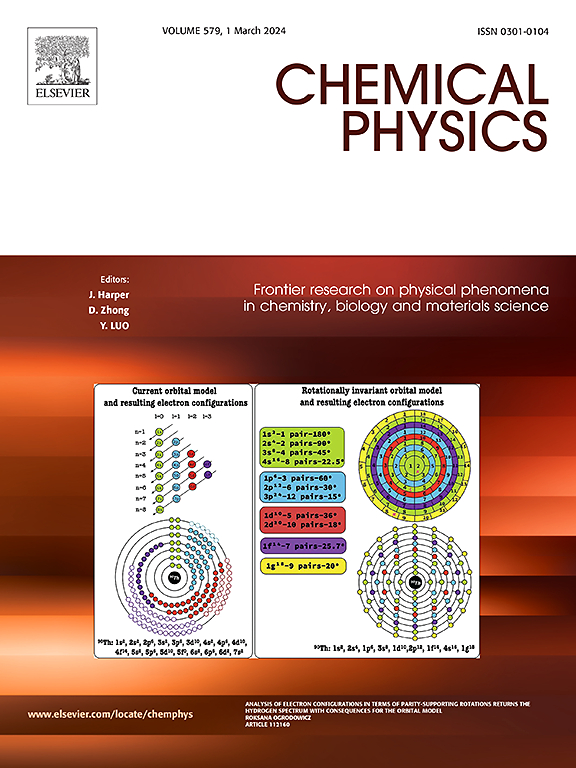N-(4-(1,3-benzothiazol-2-ylcarbamoyl)phenyl)isonicotinamide as corrosion mitigator for mild steel in 1 M HCl: A multifaceted study integrating synthesis, characterization, and molecular modelling
IF 2
3区 化学
Q4 CHEMISTRY, PHYSICAL
引用次数: 0
Abstract
Newly synthesized, cost-effective corrosion inhibitor, N-(4-(1,3-benzothiazol-2-ylcarbamoyl)phenyl)isonicotinamide (BIA) was evaluated for mild steel/1M HCl interface. BIA showed a maximum inhibition efficiency of 90.40 % at 100 ppm and 303 ± 1 K, with efficiency increasing with concentration but decreasing with temperature. Inhibitor’s adsorption followed Langmuir isotherm via physicochemical interactions. Activation parameters revealed BIA retards both metal dissolution and hydrogen evolution held in unimolecular process. Potentiodynamic polarization (PDP) divulged BIA as a mixed-type, impeding charge-transfer. Electrochemical impedance spectra (EIS) confirmed BIA forms a protective double layer, blocking active sites at the interface. Surface analysis supported a protective film formation. Global and local reactivity descriptors using DFT/B3LYP/6-311G++(d,p) were calculated to relate inhibition efficiency with BIA’s electronic properties. Molecular dynamics simulation (MDS) showed an interaction energy of −224.7 kJ/mol between BIA and Fe(1 1 0) at 303 K, with Radial Distribution Function (RDF) showing bond lengths under 3.5 Å, confirming a chemical interaction. Theoretical results align with experimental data.

N-(4-(1,3-苯并噻唑-2-基氨基甲酰基)苯基)异烟酰胺作为低碳钢在 1 M HCl 中的缓蚀剂:集合成、表征和分子建模于一体的多方面研究
对新合成的经济型缓蚀剂 N-(4-(1,3-苯并噻唑-2-基氨基甲酰基)苯基)异烟酰胺(BIA)进行了评估,用于低碳钢/1M HCl 界面。在 100 ppm 和 303 ± 1 K 条件下,BIA 的最大抑制效率为 90.40%,效率随浓度的增加而增加,但随温度的升高而降低。通过物理化学作用,抑制剂的吸附遵循 Langmuir 等温线。活化参数显示,BIA 在单分子过程中可阻止金属溶解和氢演化。电位极化(PDP)表明,BIA 是一种混合型吸附剂,阻碍电荷转移。电化学阻抗谱(EIS)证实 BIA 形成了双层保护膜,阻挡了界面上的活性位点。表面分析支持保护膜的形成。利用 DFT/B3LYP/6-311G++(d,p) 计算了全局和局部反应性描述符,从而将抑制效率与 BIA 的电子特性联系起来。分子动力学模拟 (MDS) 显示,在 303 K 时,BIA 与 Fe(1 1 0) 之间的相互作用能为 -224.7 kJ/mol,径向分布函数 (RDF) 显示键长小于 3.5 Å,证实了化学作用。理论结果与实验数据一致。
本文章由计算机程序翻译,如有差异,请以英文原文为准。
求助全文
约1分钟内获得全文
求助全文
来源期刊

Chemical Physics
化学-物理:原子、分子和化学物理
CiteScore
4.60
自引率
4.30%
发文量
278
审稿时长
39 days
期刊介绍:
Chemical Physics publishes experimental and theoretical papers on all aspects of chemical physics. In this journal, experiments are related to theory, and in turn theoretical papers are related to present or future experiments. Subjects covered include: spectroscopy and molecular structure, interacting systems, relaxation phenomena, biological systems, materials, fundamental problems in molecular reactivity, molecular quantum theory and statistical mechanics. Computational chemistry studies of routine character are not appropriate for this journal.
 求助内容:
求助内容: 应助结果提醒方式:
应助结果提醒方式:


